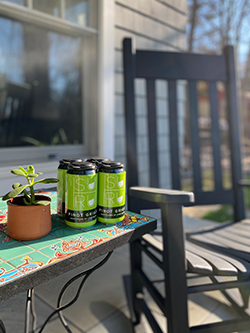Suhru Blog
May Wine of the Month: 2017 Merlot
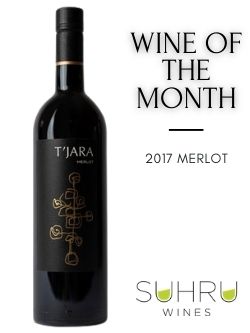
With the warm weather upon us we cannot get enough of this Merlot! While the days are getting warmer we are still enjoying cooler nights and I for one have found myself repeatedly grabbing a glass of Merlot to enjoy in the backyard by the fire. Something about the rich fruit notes and soft finish makes it the perfect compliment to the warm days turned cool nights.
Our 2017 T'Jara Merlot is fruity and luscious and everything you want in a red wine this time of year! Made in the classic old-world style, the 2017 Merlot is medium to full bodied with ripe red fruit notes of raspberry and cranberry mixed with dark notes of blueberry, blackberry and plum. Lush and round with fine tannins this easy red sipper pairs beautifully with food and stands up nicely on its own!
Keep an eye on the Blog for a few fun "Cooking with Suhru" recipes coming out soon!
Why Is Merlot So Prolific on the North Fork?
Merlot is the most widely planted variety on the East End of Long Island. This varietal flourishes in our cool climate region and ripens mid harvest, usually in the second or third week of October. Being one of the earlier ripening reds planted out here means that the fruit ripens and is harvested prior to most of the major weather events that threaten the crop, think hurricanes and early frosts.
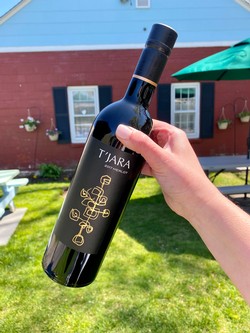 In a hotter region this variety loses its sweet fruit aromatics and mid palate fullness. Due to the hotter temperatures the fruit ripens more rapidly resulting in higher sugar content in the grapes which leads to higher alcohol in the wine which overwhelms the tannic structure of the varietal.
In a hotter region this variety loses its sweet fruit aromatics and mid palate fullness. Due to the hotter temperatures the fruit ripens more rapidly resulting in higher sugar content in the grapes which leads to higher alcohol in the wine which overwhelms the tannic structure of the varietal.
While you can grow Merlot in a variety of different regions (it is the second most widely planted grape variety on the globe), it is well established that the Bordeaux region in France is growing some of the best Merlot. If you take a closer look at the Bordeaux region, you may notice that we on Long Island are located on almost the same latitude meaning that we have a very similar climate, weather patterns, and growing conditions making us an excellent region to grow Merlot.
A Closer Look at the Vineyard
Our 2017 Merlot is made under our T'Jara label. T'Jara is the phonetic spelling of an Aboriginal word that means "place where I am from". For all of our T'Jara wines, they are grown at a dedicated vineyard in Mattituck which is located on an elevated, south facing parcel of land. This is an important feature as south facing land means that the vines get more direct sun exposure during the day leading to better grape development. In addition, the elevated nature of this piece of land in relation to the surrounding properties allows for good wind and air flow throughout the growing season.
When it comes to vineyard management air flow is key. Particularly on the North Fork where we tend to get humid and wet days during the growing season, the ample air flow ensures that the humidity does not collect around the vines which would lead to added disease pressure and rot.
In the 2017 vintage, we saw a warm growing season with a very dry Harvest period, which is what you want in the vineyard. Grape vines are one of the few crops that like a little drought pressure. Grape vines like well drained soil so for a grape grower, a dry spell is ideal because we can turn on our irrigation and control the amount of water the vines receive. In addition to the daytime weather, in 2017 the Fall evenings in the weeks leading up to harvesting in early October saw lower than normal temperatures which allowed for
longer 'hang time' on the vine before picking which resulted in the very expressive fruitiness of this wine.
Want to learn more about this vintage? Checkout our 2017 Merlot!
How Rosé Wine is Made
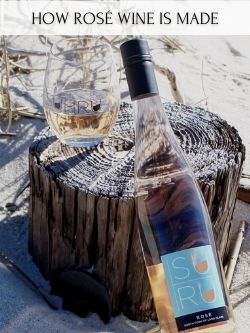
Ever wonder how rosé is made? If you are familiar with the winemaking process you likely know that when a grape reaches optimal ripeness (desired amount of sugar aka brix balancing the desired amount of acidity) the fruit is harvested and brought to the winery to begin its fermentation process.
Winemaking is both a science and an art so every winemaker will do things slightly different, however here at Suhru we are taking the Provence winemaking approach to our rosé focusing on light, fresh, fruit flavors and a light salmon hue.
To achieve this style, we purposely harvest our fruit a full 2-3 weeks earlier than we would for our red wines to ensure higher acidity in the grape. Once the fruit arrives at the winery, it is destemmed and crushed. During the crushing process the berries are split open allowing the juice to run free and be in contact with the exterior of the grape skins which is essential for color extraction. This crushed fruit is left to soak for 6 hours of skin contact which allows it to extract a nice fruitiness and light salmon hue without the body, weight, or tannin, that an extended extraction (what we typically do for red wines) would result in.
Once the 6 hour soak is complete, the fruit is loaded into the press where we gently extract the liquid juice from the grape skins and seeds before the juice is pumped into tank. At this point the juice is inoculated with yeast and begins its fermentation process.
During fermentation the yeast cells that we have introduced through inoculation begin to consume the naturally occurring sugars in the grape juice. As the yeast consumes the sugar it produces alcohol and releases carbon dioxide (CO2). Once all of the sugars have been consumed and converted into alcohol the yeast cells die and settle to the bottom of the tank. Once everything settles the clear wine is racked (aka transferred) off the solids into a new tank where it undergoes the final finishing touches (heat stabilization, cold stabilization, filtering, etc) before it is bottled, chilled and served!
New Release: 2020 Pinot Grigio
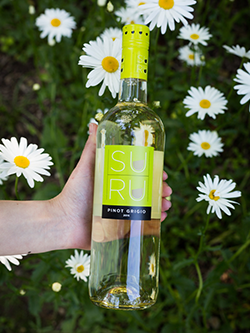 We are thrilled to announce the release of our 2020 Pinot Grigio, which recently won Gold at the 2021 New York Wine Classic! Our signature white wine from the very beginning, we are proud to say that this particular vintage is one of our best. While 2020 was a rough year for a number of regions, it was a good year to grow white wines on the North Fork!
We are thrilled to announce the release of our 2020 Pinot Grigio, which recently won Gold at the 2021 New York Wine Classic! Our signature white wine from the very beginning, we are proud to say that this particular vintage is one of our best. While 2020 was a rough year for a number of regions, it was a good year to grow white wines on the North Fork!
A Closer Look: Behind the Bottle
After the grapes are harvested, arrive at the winery, are de-stemmed and crushed, they undergo fermentation. Once the yeast have consumed all of the naturally occurring sugars in the grape juice turning it into alcohol the yeast cells die and precipitate out of the solution, settling to the bottom of the tank. The solids at the bottom of the tank are known as the lees and are most often referred to when making sparkling wine.
For the last two years we have been using a newer winemaking technique in our white wines. Once the wines finish fermentation they are racked off the fermentation lees and these lees are put aside. The fermented wine is then filtered, heat stabilized, cold stabilized, filtered again and then the fermentation lees are reintroduced to the finished wine. The wine ages sur lie (aka on the lees) post-fermentation for 4 months. This aging process adds an extra layer of richness and complexity to the wine which is evident in the long, rich finish on the wine.
 What Made 2020 Special?
What Made 2020 Special?
2020 was an excellent year for white wines. We had slightly cooler than normal nights as well as cooler days during the harvest period which retained acidity and fruit intensity in the grapes. Because of these cooler conditions the fruit ripened a little slower but held its acidity meaning that we harvested a little later than normal leading to extended fruit development. All of these factors led to wine in the bottle which is bright and crisp with robust and nicely developed fruit flavors.
Food & Wine Pairing Suggestions
Pinot Grigio is one of those white wine varieties that pairs with a huge range of foods including cheese, seafood, chicken, pasta, and more. While there are a plethora of great options to choose from when pairing this wine, one of our all time favorite pairings is Pinot Grigio and Lobster! Nothing says "Hello Spring" like a fresh lobster and a cold glass of Pinot Grigio! No matter what you choose, here's to good food, good wine, and good company!
Learn More About our New Release—2020 Pinot Grigio
How to Store Your Wine at Home
 Ever wonder what the best way to store your wine is? Suhru Wines Director or Sales & Marketing offers a few suggestions on how to store your screw cap wines in "All about Wine Storage and Preservation at Home: Tips from the Experts" on The Porch.
Ever wonder what the best way to store your wine is? Suhru Wines Director or Sales & Marketing offers a few suggestions on how to store your screw cap wines in "All about Wine Storage and Preservation at Home: Tips from the Experts" on The Porch.
The short answer—same as any other wine! When planning your wine storage you want to keep in mind two things, light exposure and temperature, both which will degrade wine over time. Wine is best stored in a cool dark environment, such as a closet or basement. However if you are keeping your wines in a basement be mindful of humidity levels in the summer. Wines under screw caps do not need to be laid down like traditional cork closed bottles as you don’t have to worry about the cork staying wet. So with a screw cap wine, find a cool, dark place, lay them down or leave them standing up, and let your wines age!
April 2021 Wine of the Month: Sauvignon Blanc
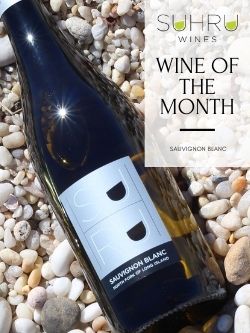 Every month we feature one of our wines, and this month is no different. As we usher in Spring and enjoy those beautiful first warm, sunny days we are proud to be highlighting our Sauvignon Blanc as our April Wine of the Month!
Every month we feature one of our wines, and this month is no different. As we usher in Spring and enjoy those beautiful first warm, sunny days we are proud to be highlighting our Sauvignon Blanc as our April Wine of the Month!
While I would (and have) happily argued that this wine is excellent in any season, I especially love it in the Spring. This wine has a soft, delicate flavor with a nice fruitiness and crisp finish that gently leads you into the warmer months while the subtle minerality begs to be paired with the local seafood and produce that is once again appearing on farm stands across the East End. Maybe it's just me, but is it really Spring if you haven't sat outside in the backyard with a glass of Sauvignon Blanc and a plate of freshly shucked local oysters?!
This month we have a number of exciting announcements and blog posts that we will be releasing over the coming weeks, so be sure to check back every Wednesday for exciting recipes, a special giveaway with our friends at Peconic Gold Oysters, and so much more! Plus, as an added bonus, throughout the month of April we are offering $6 glasses of Sauvignon Blanc at the Tasting House, be sure to make a reservation!
A Closer Look
One of our best vintages, in 2019 our Sauvignon Blanc saw changes to our winery program and we couldn't be happier with the results. As you taste this wine you may notice after the initial fruitiness of the wine subsides—gooseberry and lime on the nose and Fuji pear on the palate—you get a nice richness and round mouthfeel accentuated by an almost creamy character. With white wines we often associate creaminess or buttery characteristics with barrel fermented whites, and while this wine does not ever come into contact with oak it does have that rich, creamy depth and complexity on the finish. A newer winemaking technique that we introduced to our white wines in 2019, this wine spends 4 months sur lie after it has completed the fermentation. This process gives it that richness and added depth of flavor.
The term "sur lie" which means "on the lees" in French and refers to the process of aging a wine in contact with its fermentation lees aka the dead yeast cells. But let me step back for a moment and explain—during fermentation, yeast is introduced into the freshly crushed grape juice. The yeast cells actively consume the naturally occurring sugars in the grape juice, producing alcohol, and releasing CO2. When the yeast cells have consumed all of the sugars in the wine, they die and precipitate out of the solution, settling to the bottom of the tank.
These dead yeast cells are then referred to as "lees" and are usually racked off or in other words separated from the wine at the completion of the fermentation process. However in some cases these lees are saved and reintroduced into the wine during the aging process to add a further depth of flavor to the wine, which is what we have done with this vintage. The extended aging sur lie adds a hint of creaminess, a little more roundness to the mouthfeel, and an extra level of depth that you wouldn't see otherwise making it a more interesting and complex wine all around!
Explore Sauvignon Blanc
Spring on the North Fork
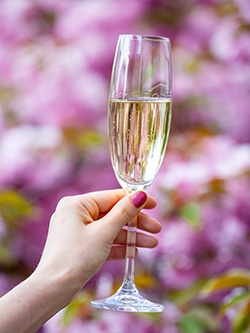
Spring has Sprung on the North Fork which calls for celebration! It has been a long, cold, snowy winter on Long Island and as much as we love winter and cozying up at home by the fire, we have been eagerly awaiting the changing of seasons. We are excited to once again be able to enjoy the sunshine, our backyards, and all of the wonderful outdoor activities our region has to offer!
There are so many amazing things to do on the North Fork and some of our favorites involve being outside and enjoying your surroundings, whether thats hiking through the woods, lazing on the beach, or sipping on a tasting at one of Long Island's many wonderful winery tasting rooms! We hope you will get the chance to enjoy the outdoors in the coming weeks and make the most of this wonderful season!
So here's to Spring and all of the wonderful things that come with it—warm weather, sunshine, longer days, enjoying being outside, backyard BBQs, cold wine, blooming of flowers and so much more!
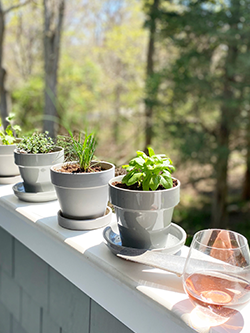 Break out the Gloves & Garden
Break out the Gloves & Garden
One of the best things about the weather getting warmer is that you can break out the gardening gloves, enjoy some time in the sunshine, and get to work! Once I have done my backyard cleanup and planted any new flower additions to the beds around my house I get to work on my favorite part of gardening season—planting fresh herbs!
If you are like me and enjoy cooking, there is nothing better than being able to step out your backdoor and pick a handful of fresh basil to whip up a homemade pesto, picking some rosemary to toss with roasted potatoes, grabbing some cilantro to mix into guacamole, or picking some fresh parsley to add a little garnish to your favorite dish!
So stop by your local farmstand or garden center (we have som many wonderful options on the North Fork!) pickup some fresh herb plants, crack open a bottle or can of Rosé (my #1 gardening wine pick) and get to work planting your backyard garden, or window sill herb garden! In addition to elevating your meals and the satisfaction that comes from planting something and watching something grow, you get a perfect excuse you get outside and enjoy the Spring sunshine!
Take a Walk by the Water
Being that we are an island, there is never a shortage of coastline to explore! There are so many excellent places to get outside and take a walk on the East End. One of my particular favorites this time of year is downtown Greenport! This bustling little seaside town has yet to reach its peak "in season" months and is not yet bustling and busy making it a perfect time (in my book) to go take a stroll and explore the town!
Greenport is the largest downtown area on the North Fork and is full of excellent restaurants, quaint little shops, the waterfront, docks, and carousel, all perfect ways to fill a Spring day!
A few of our personal favorites in Greenport are: Stop by Little Creek Oysters to shuck your own fresh oysters! Head to Crabby Jerry's for no frills seafood and waterfront dining. Looking for a more eclectic meal? Olive Branch offers gorgeous alfresco dining and delicious Mediterranean fare. If you're looking for something more casual, relaxed, and of course delicious, look no further than First & South! There really are no bad choices when it comes to Greenport, so take a walk and explore!
Relax with a Can
About a year ago in Spring of 2020 we released our first ever Suhru Wines in cans—offering our Pinot Grigio and Rosé—a year later we are very pleased to say they have been a huge success and we are looking forward to watching them continuing to grow!
The great thing about wine in cans is how portable and convenient they are! Heading to the beach or out on the boat? Throw a 4-pack in the cooler! No need to worry about packing glasses or bringing that heavy glass bottle home with you. Whether you are taking them on the go, sipping on a can while you garden and take care of things around the house, or while enjoying a quiet moment on the porch after a long day, you can't beat their convenience!
Plus the truly great things about cans (and one that we don't often talk about) is because aluminum is an entirely opaque material there is no risk of light or oxygen exposure to the wine, ensuring that it is as fresh, crisp, and bright the day you open it as they day it was canned!
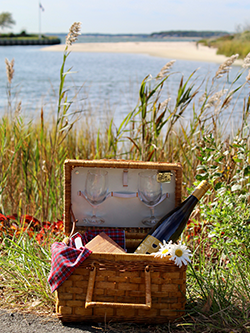
Pack a Picnic
If I had to pick an all around favorite North Fork activity this just might be it—I love picnics! We have so much open space out East and when you combine a selection of tasty treats, either from my kitchen or one of the local shops, with an afternoon spent outside enjoying a few hours by the water, in a park, on the beach, or simply in my backyard, it just makes everything better!
No need for anything fancy, you can pickup a few snacking favorites at the grocery store and pack a bottle of wine, but if you're looking to step up your game stop into one of these great shops on Love Lane for a delicious and vast selection of snacking and light dinner options. A few of my picnic necessity go-to shops are: Lombardis Love Lane Market which has everything you could possibly want for a picnic including meats, salads, spreads, and bread options to prepared hot items and a nice selection of sweets. Next stop is the Village Cheese Shop which naturally has a wide selection of cheese, so pick out a favorites or two, grab and accouterments you like such as crackers or spreads and then head around the corner to Agora to round out your picnic with a few eclectic items. Agora Greek Market has a wonderful selection of traditional Greek desserts, olives, cheeses, and my favorite dolmades!
Wherever life takes you on the North Fork this Spring you are sure to enjoy! Here's hoping everyone has a chance to get outside, enjoy the sunshine, and maybe enjoy a glass or two! Happy Spring!
Looking for More To Do on the North Fork, Checkout the "Out East" section of the Suhru Blog!
New Release: 2019 Dry Riesling

We are VERY excited to announce the release of our new Dry Riesling, a wine that is already creating waves in the wine world! Our 2019 Dry Riesling was recently awarded a Double Gold medal and a 96 point score from the 2021 International Eastern Wine Competition! Not a bad way to kick off a new vintage release!
A Closer Look: Behind the Bottle
As in years past, our 2019 Dry Riesling was made entirely in stainless steel tanks to accentuate the minerality of the wine which brings out the bright, crisp acidity on the finish. When it comes to acidity in a wine, what you taste is driven by the pH.
The More You Know: In chemistry, pH is a scale used to determine the acidity or basicity of a liquid. The higher the pH the more basic the liquid, the lower the pH the more acidic it is.
Over the last few years the pH of our Dry Riesling has sat around 3.2 with 8 g/L of residual sugar. However in the 2019 vintage we saw a more vigorous growing season with more sun days at the vineyard in the Finger Lakes where we grow our Riesling fruit. Because of this, the grapes ripened earlier than in years past resulting in riper fruit while the pH remained low—the ideal scenario when it comes to growing white wines. Therefore our 2019 Dry Riesling has a slightly higher residual sugar than years past at 9g/L to balance its lower pH of 2.8.
Why is Acidity So Important?
When it comes to taste there are five main flavor categories—salt, fat, umami, acid, and sweet. In the wine world we tend to focus on acid and sweet, pulling in the other three when we are talking about food pairings.
Acidity and sweetness fall on opposite ends of the flavor spectrum so when you have a wine with residual sugar, the lower the pH the less sweet it will taste, as the brightness of the acidity comes through as the primary flavor. This phenomena is on prime display in our 2019 Dry Riesling which jumps from the glass upon first sniff. With bold, bright aromatics this wine has rich notes of honey and apricot mingled with a slight hint of plum on the nose with crisp notes of clementine, white peach, and starfruit on the palate.
Food & Wine Pairing Suggestions
An extremely food-friendly wine, known as one of the favorite food pairing wines by sommeliers, our Dry Riesling pairs wonderfully with a variety of Asian cuisines and spicier foods such as sushi, curries, Thai foods, dry rub barbecue, and more! This wine's rich minerality, vibrant fruit notes and bright acidity will leave you craving a cheese plate and a platter of blackened fish tacos! We will be releasing more information on this wine and a number of fun food pairings over the coming weeks, so stay tuned! Can't wait for more? Checkout our recent "Cooking with Suhru: Vegetable Curry & Dry Riesling" post!
Learn More About our Dry Riesling
Wine Tasting 101
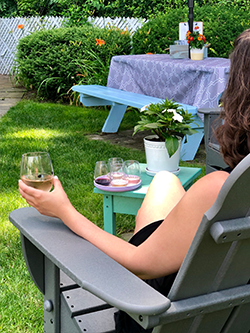 If you're planing a trip to wine country or simply tasting wines at home there are a number of helpful hints, tips, and tricks to ensure you get the most out of your tasting experience however one of our favorite (and the easiest to remember) is the 5 S's—Sight, Swirl, Sniff, Sip, Savor (or Spit, that's up to you).
If you're planing a trip to wine country or simply tasting wines at home there are a number of helpful hints, tips, and tricks to ensure you get the most out of your tasting experience however one of our favorite (and the easiest to remember) is the 5 S's—Sight, Swirl, Sniff, Sip, Savor (or Spit, that's up to you).
Sight
When it comes to tasting we all assume that our tongue is the main muscle we're flexing and while it is the main one, there is more to tasting than just "taste". Your sense of sight can tell you a lot about the wine before it even reaches your lips. Once the wine has been poured into your glass take a look at it, what do you notice? Right off the bat you should be able to tell first and foremost is it a white, red, or rosé wine? Is it still or sparkling?
Place your glass over a white surface and examine the color. Is it pale and translucent or rich and opaque? If it is a red wine, is the color consistent or do you see some browning on the edges? All of these characteristics and more will allow you to start to assess the wine in the glass, make certain observations and conclusions, and get a better sense of what the wine will taste like.
The color of a wine can tell you a lot about the wine in the glass. If a white wine is lighter in color it is likely stainless steel fermented and on the drier side whereas a honey hue in a white wine is often the sign of barrel aging or the presence of more residual sugar. If you are looking at a red wine similar observations can be made, often lighter bodied wines will be paler in color leaning more towards the red side of the color spectrum whereas fuller bodied reds with more tannic structure will be deeper and often more opaque in color.
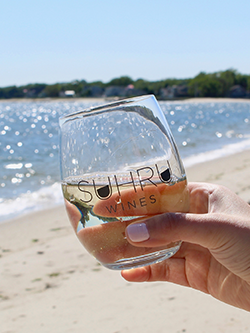 Swirl
Swirl
An often overlooked step in the tasting process, swirling a wine in your glass has several meaningful results (other than just making you look fancy!). Swirling a wine in the glass exposes it to oxygen. While we often talk about oxygen in relation to wine as a negative (think wine turning into vinegar) controlled oxidation allows the flavors and aromatics to open up. By swirling a wine in the glass you are increasing the surface area of the wine and exposing more of the wine to oxygen, similar to the process taking place when a wine is decanted. As you swirl you'll start to notice more aromatics being release.
Pro Tip: Hold your glass by the stem or bottom of the bulb (if using stemless) and slowly rotate your wrist to move the wine around the edges of the glass. The swirl is all in the wrist, people often incorporate the whole arm into this movement which can lead to wine sloshing over the rim of the glass, which no-one wants.
Sniff
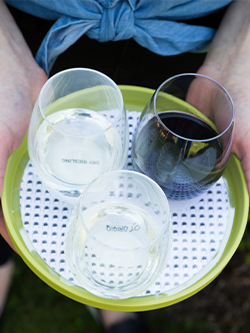 Your sense of smell and your sense of taste are very closely related, as your nose and throat connect to the same airway. Which for example, is why when you have a cold and a stuffy nose, your sense of taste is diminished. Smelling a wine in the glass is a good first step in assessing the flavor profile of the wine. Stick your nose as far into the glass as you can and take a deep inhale, what do you smell? Notice the fruit notes. In a white wine, do you notice tropical and stone fruits or more citrus? For a red wine, do you detect red (raspberry, red currant, strawberry, red cherry) fruit notes or more on the black (blueberry, plum, blackberry, dark cherry, dark currant) fruit side of things? What about oak?
Your sense of smell and your sense of taste are very closely related, as your nose and throat connect to the same airway. Which for example, is why when you have a cold and a stuffy nose, your sense of taste is diminished. Smelling a wine in the glass is a good first step in assessing the flavor profile of the wine. Stick your nose as far into the glass as you can and take a deep inhale, what do you smell? Notice the fruit notes. In a white wine, do you notice tropical and stone fruits or more citrus? For a red wine, do you detect red (raspberry, red currant, strawberry, red cherry) fruit notes or more on the black (blueberry, plum, blackberry, dark cherry, dark currant) fruit side of things? What about oak?
Pro Tip: Whenever you are tasting you want to ensure that what you are smelling is coming from the glass, not from your surrounding environment. While perfume and scented lotions are all great, it is best to skip it on days you are tasting as the aromas from the perfume will influence what you and the people around you taste in the glass.
Sip
Now its time to taste! Give the glass one more nice swirl, take a deep inhale, and take a sip. Let the wine sit on the top of your tongue, move it around your mouth making sure it comes in contact with the roof of your mouth and the sides of your tongue. What do you notice? What flavors jump out to you? Do you find yourself salivating from the acidity? Are you experiencing any drying sensations in your mouth coming from the tannins? Take another sip, this time while holding the wine in your mouth pull a small amount of air across your tongue, swish the wine around, swallow, and with your mouth closed exhale through your nose? What additional flavors do you notice?
Pro Tip: When it comes to tasting your pallet is key. Avoid gum, coffee, or strongly flavored foods prior to tasting and never brush your teeth just before a tasting as the flavors will diminish your tasting abilities.
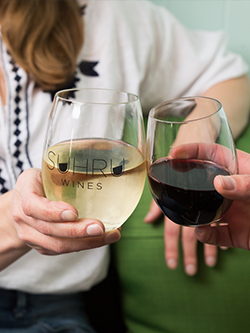 Savor (or Spit)
Savor (or Spit)
This last and final step is everyone's favorite! You have reached the main event and now can enjoy the wine in your glass without having to worry about identifying flavors or characteristics. However the fun doesn't stop here. While you have reached the end of the S's there are plenty more ways to explore the wines you have in front of your the main one being combine the tasting experience with food.
One of the things we often forget when tasting wine is how those flavors interact on the palate once additional flavors are introduced which is why it is always best to taste a wine on its own as well as with food to see how the flavors change and evolve. Taste the wine in your glass with a meal, with a cheese or charcuterie spread at the Tasting House, or simply with a cracker and see how the flavor profile changes and evolves, happy sipping!
March 2021 Wine of the Month: Teroldego
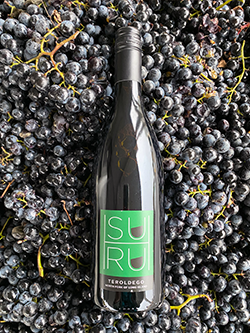 One of the more interesting and unique wines in the Suhru Wines family, Teroldego is a Northern Italian red variety primarily grown in the Alto Adige region of Northern Italy. With only one known planting on Long Island, we count ourselves lucky to have access to and be able to produce this robust and delicious wine.
One of the more interesting and unique wines in the Suhru Wines family, Teroldego is a Northern Italian red variety primarily grown in the Alto Adige region of Northern Italy. With only one known planting on Long Island, we count ourselves lucky to have access to and be able to produce this robust and delicious wine.
Our Teroldego has quickly become a staff favorite at Suhru! With its deep color, rich red fruit notes and warm baking spices on the nose with delicious red pairs wonderfully with a wide range of dishes from grilled swordfish, roasted duck, teriyaki salmon, gamey poultry, apple pie, walnut goat cheese pear salad, or brisket just to name a few!
If you haven't yet had the chance to taste this tantalizing red, be sure to stop by the Tasting House this month, as it is featured on our tasting menu this March as our Wine of the Month!
A Note from our Winemaker, Russell Hearn
"I have always enjoyed the Alto Adige grape Teroldego as a consumer but never thought about its connection to our region. When Reagan Meador (previously the owner of Southold Farm + Cellar) produced wines at Premium Wine Group I was reminded of the varieties affinity to a cool climate region. When he sold his vineyard I made it a mission to lease/source fruit from this vineyard and in 2019 succeeded producing our first Suhru Teroldego.
Teroldego is one of many well suited varieties to our region but the beauty of this variety in particular is how early it ripens (early to mid October) meaning that is ripens before it becomes at risk from some of the later harvest natural weather events we experience such as hurricanes and early frosts."
A Closer Look at the Vineyard
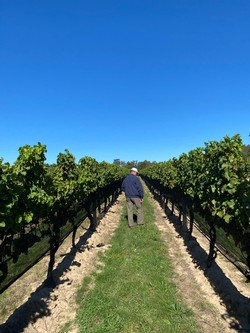
When talking about grapes and winemaking we often find ourselves discussing a region or a vineyards "terroir". In case you're not familiar with this term, terroir refers to the influences of soil, climate and human intervention on the grapes. Each region and each vineyard has its own specific terroir that influences how grapes grow and taste. When it comes to the North Fork of Long Island, it is our maritime climate (proximity to the ocean which regulates our seasons and temperatures) and our sandy loam soils (the result of glacier deposits) that are some of the largest contributors to our unique growing conditions.
The soils of the North Fork differ very little in the loam/sand/silt composition however the highest variable is the sand. This changes how quickly summer rains percolate through and out of the root zone which is essential when we are looking at grapes. Grape vines are one of the few crops that prefers less rather than more rainfall as they do not like standing water in or around their roots.
Our cool Maritime climate is very suitable to the ripening requirements of Teroldego. Our Teroldego vineyard, located in Southold, is moderately high in the loam/silt content so retains water a little longer than others and the vines ripens more gradually. Vineyards with sandier soil compositions on the other hand ripen earlier as the sand heats up warming the ground and ripening the fruit.
Teroldego is an early ripening red (early to mid October) that does not like or need a lot of heat for maturity so the silt/loam soils content allows for slower more gradual ripening ensuring a fully ripened berry in the cooler months of the fall when the grapes can retain higher acidity.
This site is a little elevated versus its surrounding land so it receives all the wind generated from the land/water effect of a Maritime Climate. This helps decrease humidity by enhancing air movement to reduce 'fungal disease pressure'.
Interested in learning more about this fascinating, lesser known varietial?
Check out our "History of the Grape" blog post!
Corks vs Screw Caps
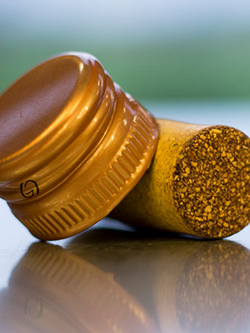 Ever wondered about the differences between the traditional cork closure and the more modern screw caps? Today we are taking a deep dive into the two technologies and shedding light on the history and benefits of the two!
Ever wondered about the differences between the traditional cork closure and the more modern screw caps? Today we are taking a deep dive into the two technologies and shedding light on the history and benefits of the two!
A Brief History of the Corks
Cork has been in use since 3000 BC and is used in a wide variety of products including shoes, flooring, bags, and of course as a closure for wine. Cork products are made by harvesting the bark of a Quercus Suber oak trees aka a Cork Oak, which takes 25 years of growth to reach maturity and to a point where the bark can be harvested. The process of harvesting is done by hand by specially trained cork harvesters who strip the bark from the trees using an axe.
As an organic material cork is a wonderful natural product, however as with any organic material it is subject to contamination. One of the reasons cork has been the material of choice for centuries is that its porous nature allows gradual oxidation for the wine as it bottle ages. However because it is a natural product there can be quite a lot of variation from cork to cork which can lead to something called sporadic oxidation.
Sporadic oxidation is the result of inconsistency in pore size of the cork, leading to the allowance of more or less oxygen to pass through the cork into the bottle. This can result in a browning in color, maderized (baked or stewed) character, loss of primary fruit and a general flattening of flavors and shortening of the finish of the wine. This comes from the varying elasticity of the corks, more or less lenticels (holes size and quantity), the internal bore of the glass neck, imperfections of the corking machinery can cause slices in the cork all of these can create variable issues with a perfect seal.
Cork Contamination aka "Corked" Wine
One of the other most commonly referred to downsides of cork closures is TCA (trichloroanisole), the primary form of wine contaminantion, also referred to as a “corked” or spoiled bottle of wine.
TCA is created when chlorine comes in contact with molds that form naturally in the bark of Quercus Suber oak trees. Chlorine is introduced during the washing of the bark when it is cut and from spray residue from pesticide sprays on the trees. Some of the tell-tale signs of a TCA contaminated or "corked" bottle of wine is a ‘wet-cardboard’ and ‘wet dog’ aromas, paired with suppressed fruit and a shortened finish. The flavor and aromas are distinct and are easy to pick-out once you know what to look for. The wine industry estimates that between 5-10% of all wine bottled under cork has some level of TCA.
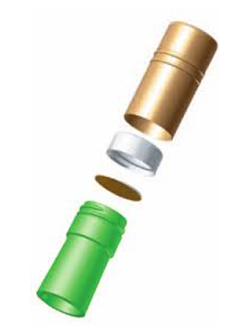 Introduction of Screw Caps
Introduction of Screw Caps
In August of 1889 Dan Rylands of Barnsley in the UK patented the screw cap, however it would be another 70 years before screw caps were used in wine packaging.
If you look inside a screw cap you will see a coating on the interior which is its PVDC liners (polyVINylidene chloride) essentially the ‘wine-proofing layer.’ This is then coupled with either Tin or Saranex backing based on the winemaker's preference. Tin linings (which are 10% more expensive) prevent oxygen exchange and retain freshness in a wine. Tin linings are primarily used for white and rosé wines. On the other hand, saranex linings which are mainly used for red wines allow the wine to breathe.
In 1959 a French company, Le Bouchage Mecanique (now Pechiney) was the first to use screw caps on a wine bottle. In the 1960's a Bordeaux winery bottled multiple vintages in screw caps as a trial to test out the new technology. Unfortunately for them they used paper wad backing not saranex in the cap. Ten years later in the early 1970's the Swiss wine industry was the first to fully embrace the new screw cap closures and by 1980's it was the predominant closure being used.
In the 1970’s Australia confirmed the superiority of the closure for red and white wines using tin or Saranex depending on the wine, but the change was met with strong consumer resistance. However in the early 2000’s the industry once again embraced this closure (starting with Claire Valley high-end Riesling producers) and over the last two decades screw caps have gained industry and consumer popularity across the globe.
Corks vs Screw Caps, Which is Better?
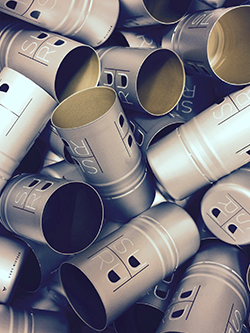 A closure has a direct impact on the quality, stability, longevity and even proper storage of the wine. While cork has been the historic choice and for a great many years was the best option available, in the modern age screw caps have become superior due to the consistency they provide.
A closure has a direct impact on the quality, stability, longevity and even proper storage of the wine. While cork has been the historic choice and for a great many years was the best option available, in the modern age screw caps have become superior due to the consistency they provide.
Screw caps offer a reliable seal that is consistent from bottle to bottle unlike cork which due to the fact that it is an organic material has slight variations from one cork to another that result in slight differences, and sometimes spoilage in the bottle.
One of the other main benefits and one that is often overlooked is that screw caps are inert, meaning they are flavorless and do not add any flavor (be it positive or negative) to the wine. On the other hand corks, introduce flavor both positive through slow oxygen exchange which allows wine to age in the bottle as well as negative (TCA) which results in spoilage. Screw caps, while inert, can be customized to allow for gradual slow oxygen exchange by adding a foam insert to the top of the screw caps interior thus mimicking the slow oxygen exchange of corks.
Temperature is often discussed as one of the main detriments to wine as it deteriorates the quality of the wine over time and causes spoilage. If you have ever opened a bottle of wine after it has sat baking in a car on a hot summers day you know what I'm talking about, the wine gets "cooked" and no longer tastes as it should. While a wine can get "cooked" no matter what closure you have, when a bottle with a traditional cork closure reaches 85 degrees Fahrenheit the cork will start pushing its way out of the top of the bottle exposing the wine to more oxygen and increasing the rate of spoilage/oxidation over time, whereas with screw caps you don’t run into this issue as the caps can hold more internal pressure and therefore are less effected by temperature swings.
Another main benefit of screw caps is their price, while pricier options do exist, there are affordable options when compared to many of their cork/capsule counterparts, meaning less packaging costs for the winery and therefore a better bottle price for the consumer, a win-win for everyone! For comparison, a natural cork costs $0.25 - $0.45 per cork plus the capsule is an additional $0.15 for polylamanents or roughly $0.02 for plastic. A stelvin screw caps costs $0.18 per cap and the higher end lux screw caps costs $0.50.
And if all of that wasn't enough to convince you that screw caps are the way of the future, one of our favorite features are how easily screw caps can be opened and resealed. No need to struggle with a corkscrew or ensure you have one on you, all you have to do is give the bottle a quick twist and your wine awaits! In addition to the ease of opening, screw caps are a green product, the are cost effective and easily recycled. Aluminum (what screw caps are made of) happens to be the most cost effective material to recycle and if that's not a plus I don’t know what is!
Suhru has been proudly packaging our wines under screw caps since we opened in 2008 and have seen great success in the age-ability of our wines under these closures. Many experiments have been done in regions across the world comparing screw caps to cork and the screw caps has come out equal if not better than the cork at aging in may cases. While it may be a "less romantic" way to open your wine, you can't beat the convenience!


